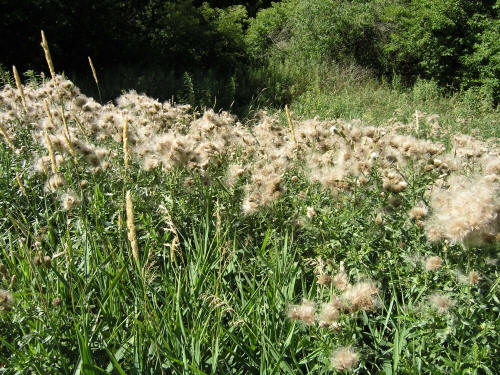Canada Thistle
Canada Thistle
Cirsium arvense L.
Asteraceae (Sunflower Family)
▲ ▼ seedlings
▲ ▼ young shoots from creeping roots
▲ ▼ young shoots from creeping roots
▲ ▼ young shoots from creeping roots
▲ ▼ abundant, deep, fleshy creeping roots

▲ ▼ flowering plants are relatively short, and have thin, upright, slightly branched stems and small inflorescences (usually 1" diameter or smaller); the following flowering plants from around the U.S. show an array of flower colors and leaf characteristics
▲ ▼ flowering plants
▲ ▼ flowering plants
▲ ▼ flowering plants
▲ ▼ flowering plants

▲ ▼ flowering plants
▲ ▼ large 30+ foot diameter clonal colony of Canada thistle in Minnesota
▲ ▼ inflorescences/flowers

▲ inlforescence in bud and flowering
▲ ▼ closer view of inflorescences/flowers

▲ ▼ inflorescences after flowering and beginning to release seed
▲ ▼ fruit of Canada thistle

Cirsium arvense (L.) Scop., Canada thistle: (Bayer Code: CIRAR; US Code CIAR4)
- A creeping perennial noxious weed in mostly northern U.S. (northern Midwest and northern Missouri) that can produce dense, large colonies
- Is a short thistle, growing from 6 inches to 4 feet tall at flowering, averaging around 2-3 feet tall, often of varying heights in colonies
- Usually does not have leafy wings on stems
- Leaves can be quite variable, from nearly hairless to quite hairy; leaf undersides can be green to white; leaf margins usually lobed, with spines along margins; margins may be flat or wavy-edged
- Flower heads are at tips of stems in panicle-like arrangements
- Individual flower heads are smaller than many thistles, usually 0.5 to 1 inch diameter, and disk flowers are pinkish-purple (occasionally white)
- Bracts below flower head are not cobwebby and do not have spines, outer bracts taper to long tip
- Stems are solid, and can be green to purplish-brown, usually ridged, not winged
- Creeping roots are fleshy and easily broken, allowing spread by tillage; roots can go to about 10 feet deep, sometimes deeper; 60% of roots are over 2 feet deep
- Creeping roots can spread horizontally 10-20 feet diameter per year
- Their wide genetic variability produces a wide range of susceptibility in response to herbicide applications
- Tends to be dioecious, with separate male and female plants
- Produces many seeds which can remain viable for over 20 years
- Seedlings grow slowly at first, produce creeping roots at 7-9 weeks
- Shoots from creeping root shoots emerge in March-May
- Blooms May-August
- Inactive after bloom until late summer to early fall, they put on new growth up into November
- Various biological control agents are being evaluated for its control--a gall fly, a stem-mining weevil and a seedhead weevil
- Can distinguish Canada thistle from most other thistles (tall thistle, bull thistle, musk thistle or field thistle) by its small stature and flower size and that it often appears in colonies due to its vast creeping root system
Some white flowering forms of Canada Thistle:
(Updated January 23, 2019)